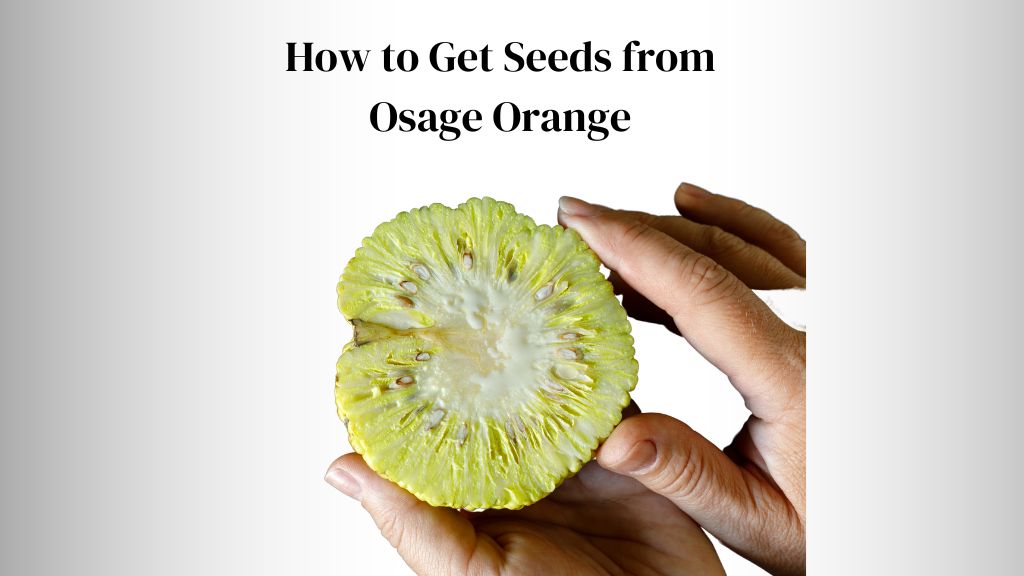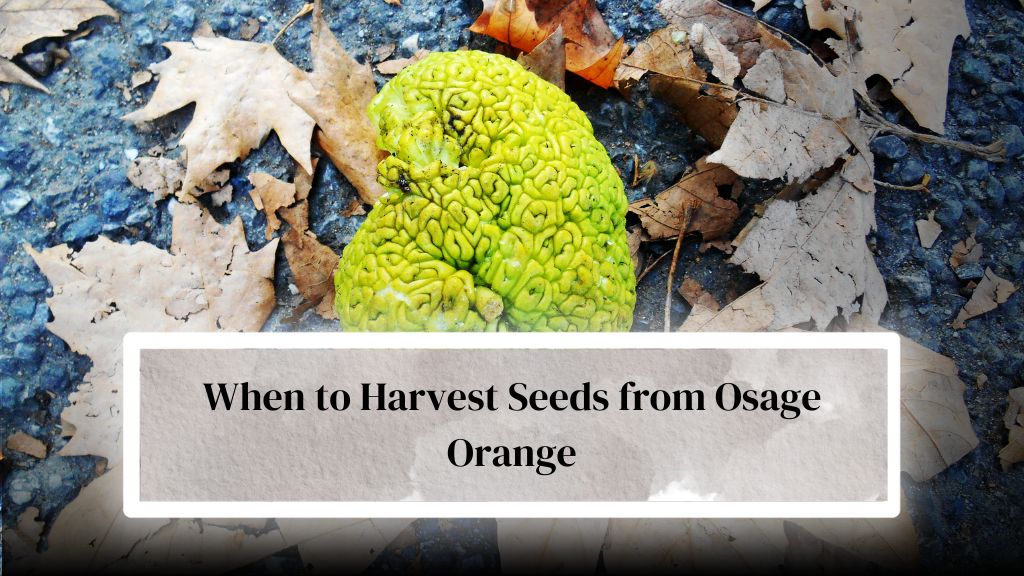
If you’re wondering how to get seeds from osage orange, don’t worry. In this article, I will help you learn when to harvest seeds from Osage orange, how to prepare for seed collection, and some tips to increase your chances of successful germination.
Since the fruit of Osage orange contains seeds that you can harvest & plant to grow new trees, let’s take a quick look at when to harvest seeds from Osage orange and how to get seeds from Osage orange fruits.
When to Harvest Seeds from Osage Orange

According to research by Iowa State University, the ideal time to harvest Osage orange for seeds is between late September & early November, when you notice fruit turning yellow or brown and falling to the ground.
At this stage, the seeds are often mature and have the best chance of germinating successfully. However, you should note that the weather conditions, soil type, and age of the tree can also affect the maturity of Osage orange seeds.
This is why I highly recommend you find a healthy tree to get a seed for germination. It is best to get seeds from my younger tree as they tend to have a higher germination rate than those from older trees.
You can also look for trees grown in moist soil as those are known to produce more seeds with higher germination rates than trees grown in dry soils. However, make sure always to check if the seeds from the tree you’re taking are ready for harvest or not.
There are many signs of fruit maturity, like a change in color, softening of the fruit, and the presence of viable seeds inside it. When you cut open the fruit, you must notice a viable seed that is firm, brown, and free of mold or fungus.
Preparation for Seed Collection
Tools Needed for Seed Collection
You will need gloves, a bucket or bag, and pruning shears or a saw to collect Osage orange seeds. You should know that thorny branches of the tree can be dangerous, so wearing gloves to protect your hands is essential. A bucket or bag is also necessary to collect the fruit & seeds, while you can use pruning shears or a saw to cut the branches from the tree.
Safety Precautions
When you’re collecting Osage orange seeds, it is essential that you also take safety precautions to avoid injury. As I told you earlier, osage orange trees can have sharp thorns, so it’s better if you wear gloves & long-sleeved clothing to protect your skin. Also, you should be careful if you’re pruning shears or a saw to avoid injuring yourself or damaging your tree.
Preparation of the Collection Site
Before harvesting Osage orange seeds, it is essential that you also prepare the collection site. Therefore, I’ll highly advise you to clear any debris around your tree to make it easier to collect the fruit & seeds. Spreading a tarp or sheet on the ground is also helpful in catching any falling fruit or seeds.
How to Get Seeds from Osage Orange

Step-by-Step Guide for Seed Collection
- Wait For The Fruit To Ripen: You can’t just go and take a fruit from the tree to get the seed out of it anytime. It would be best to wait until the tree fruit produces its fruit.
In general, Osage Orange trees produce fruit in the fall, which can take several months to ripen. Therefore, you need to make sure you either wait for the fruit until it’s ready for harvest when it turns yellowish-green & starts to fall from the tree. - Collect the fruit: Rather than taking the fruits directly from the tree, you can also gather the fruit from the ground. However, always wear gloves as the sticky milky SAP of these fruits can irritate your skin & give allergic symptoms.
- Remove the seeds: To use and remove the seeds, you must use a clean knife or a pruner. Make sure you cut the fruit open while wearing a glove and carefully remove the seeds of the fruit.
In general, each Orange fruit should contain up to 20 seeds. After removing the seeds from the fruit, you must wash it thoroughly to remove any remaining pulp or sap.
Techniques for Seed Extraction
There are several techniques for extracting the seeds from Osage Orange fruit. One common method is to soak the fruit in water for several days until it softens and the seeds can be easily removed.
Another method is to freeze the fruit and thaw it, which can help break down the pulp and make it easier to extract the seeds.
Storage and Preservation of Seeds
If you want to wait for the right time to plant osage orange seeds or are a supplier of them, you need to store them properly to ensure they remain viable. I usually place the Osage Orange seeds in a sealed container and store them in a threshold place.
| Viability | Storage Method |
| 1-2 years | Room temperature |
| 3-4 years | Refrigerator |
| 5+ years | Freezer |
How to Germinate Osage Orange Seeds
Once you have harvested the Osage Orange seeds, it’s time to germinate them. Here are some tips for successful germination:
Ideal Conditions for Germination
You should note that Osage Orange seeds require specific conditions to germinate successfully. The ideal temperature range for germination of Osage orange trees is between 70-85°F (21-29°C). It would be best if you planted these seeds in well-draining soil with a pH range of 6.0-7.5.
Pre-Germination Treatments
If you want to increase the chances of successful germination, there are a few pre-germination treatments that you can use. People often avoid scarfing the seed to prevent Overcrowding.
However, if you want, you can make small cuts or scratches on the seed coat, allowing moisture to penetrate more easily. Another method I like is to soak the Osage orange fruit seeds in fresh water for at least 24-48 hours before you get ready to plant them.
Techniques for Successful Germination
You must plant the seed 1-2 inches deep in the soil to help it germinate better. After planting the seed, you must keep an eye on the soil’s moisture. It is important to keep the soil moist but not soggy.
In addition, you should always provide proper protection to the seats and young trees from extreme temperatures that may reduce their viability. You should note that the siblings from the osage orange seeds should have emerged within 24 weeks.
Once you notice the siblings are 6 to 8 inches in size, you can transplant them to another permanent location where they will have no competition for resources.
Caring for Osage Orange Seedlings
Soil and Water Requirements
As I told you earlier, Osage orange seedlings require well-draining soil that is moist but not soggy. Once you notice the seedlings have emerged, you must water them regularly to keep the soil moist. However, be careful not to overwater, as this can lead to problems like root rot.
As the seedlings grow, you can easily transplant them into larger pots or the ground as you wish. To prevent make mistake, consider to read my comprehensive guide on “How to Grow Osage Orange Trees?“
Light and Temperature Needs
You must place them in a location that receives at least six hours of direct sunlight daily. Osage orange trees are hardy in USDA zones 5 through 9 and can tolerate temperatures as low as -20°F.
Pest and Disease Management
Osage orange trees are considered to be fairly resistant to pests & diseases. However, it doesn’t mean they can’t be susceptible to damage. It would help to keep your tree protected from deer, rabbits, & other wildlife. If you have young seedlings, you should protect them by placing a fence around them or using a repellent spray.
Conclusion
In this article, I have given my best to give your proper answer and in-depth information on the question ‘how to get seeds from Osage orange’ If you find this article helpful, consider sharing it. Your share will help many people learn about the rewarding experience of harvesting & germinating osage orange seeds.
You should use proper techniques and provide conditions that suit new Osage Orange tree growth for better success. It’s also important that you not only wear gloves when handling fruit or seed but also when you are harvesting it and storing it properly, ensuring its viability.
Do check our other helpful guide on osage orange tree care & management. See you in the next post. Till then, take care and goodbye.
